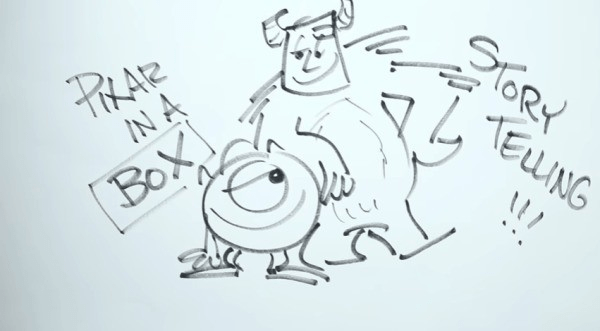ピクサーでは、ジョン・ラセターが提唱する
“Story is King.”(ストーリーこそ王)
という製作哲学があります。
こちらのサイトが日本語で解説されています:https://xrosriver.com/2017/02/22/pixar-in-a-box-storytaling-technic-01/
- 1 “Story is King.”
- 2 ピクサーの22のストーリールール
- 2.1 1.成功ではなく、あきらめずに挑戦する姿勢
- 2.2 2.だれにとって面白い話なのか
- 2.3 3.ストーリーからテーマを伝える
- 2.4 4.ストーリーラインの定番
- 2.5 5.分かりやすく登場人物の魅力を伝える
- 2.6 6.登場人物に試練を与える
- 2.7 7.エンディングを決めておく
- 2.8 8.完璧でなくてもいい。次はもっと上手く書こう
- 2.9 9.多くのリストから良いアイデアが浮かんでくる
- 2.10 10.自分のアイデアに囚われすぎない
- 2.11 11.書いて頭の中を整理する
- 2.12 12.最初のアイデアは無視する
- 2.13 13.登場人物に命を吹き込む
- 2.14 14.あなたの信念を伝える
- 2.15 15.リアルな感情表現で読者を巻き込む
- 2.16 16.登場人物の背景がストーリーを面白くする
- 2.17 17.無駄な仕事はない
- 2.18 18.自分を知ろう
- 2.19 19.偶然はストーリーを盛り上げ、興ざめもさせる
- 2.20 20.エクササイズ(練習)
- 2.21 21.リアルな表現でストーリーを展開する
- 2.22 22.伝えたいことを一言で表す
“Story is King.”
注意したいのは、はじめに描いたストーリー(コンテ)が絶対ではないということです。
スタッフ1人1人が伝えたい物語を
「どのようにフォローできるか?」
「より物語を強調するためにはどうしたらよいのか?」
日々頭を使い、悩んでいます。
それはレイアウトでもアニメーションでも同じことで、
「22のストーリールール」は脚本家やコンテマンだけのものではなく、
プロジェクトにかかわる全ての人に知っておいたほうが良いルールなので、
ぜひこれらの内容をインプットしてみてください。
ピクサーの22のストーリールール
1.成功ではなく、あきらめずに挑戦する姿勢
You admire a character for trying more than for their successes.
成功よりも主人公が挑戦し続けることを誉めよう。
2.だれにとって面白い話なのか
You gotta keep in mind what’s interesting to you as an audience, not what’s fun to do as a writer. They can be v. different.
(大事なのは)書き手にとっての楽しい話ではなく、読者にとって面白い話と覚えておくこと。この二つはまったく違う。
3.ストーリーからテーマを伝える
Trying for theme is important, but you won’t see what the story is actually about til you’re at the end of it. Now rewrite.
テーマ探しは非常に重要だ。でも、どんなストーリーになるのか書き終わるまで分からない。だから書いたらリライト(書き直し)して本質を明らかにしよう。
4.ストーリーラインの定番
Once upon a time there was ___. Every day, ___. One day ___. Because of that, ___. Because of that, ___. Until finally ___.
むかしむかし、あるところに、、、。毎日、、、。ある日、、、。そうして、、、。そうして、、、。ついには、、、。
5.分かりやすく登場人物の魅力を伝える
Simplify. Focus. Combine characters. Hop over detours. You’ll feel like you’re losing valuable stuff but it sets you free.
簡単に。集中して。登場人物を交わらせよう。回りくどいことはやめて。(あなたが用意した多くの説明を削ぐのは)大事なものを失うように感じるけれどそれでいいんだ。
6.登場人物に試練を与える
What is your character good at, comfortable with? Throw the polar opposite at them. Challenge them. How do they deal?
登場人物は何が好きで、何が心地いいんだろう? それとは真逆の試練を与えてみよう。どのように立ち向かうんだろう?
7.エンディングを決めておく
Come up with your ending before you figure out your middle. Seriously. Endings are hard, get yours working up front.
ストーリーの中盤に入る前にエンディングを決めておこう。真剣に。エンディングは難しい、だからこそ前もって決めておくんだ。
8.完璧でなくてもいい。次はもっと上手く書こう
Finish your story, let go even if it’s not perfect. In an ideal world you have both, but move on. Do better next time.
ストーリーを書き上げたら、それが完璧でなくても世に出そう。理想は2つとも揃うことだが、世の中は動いている。次はもっと上手く書こう。
9.多くのリストから良いアイデアが浮かんでくる
When you’re stuck, make a list of what WOULDN’T happen next. Lots of times the material to get you unstuck will show up.
ストーリー展開に行き詰ったら、“あり得ない次の展開”のリストを作ろう。何度もやれば良いアイデアが浮かんでくるよ。
10.自分のアイデアに囚われすぎない
Pull apart the stories you like. What you like in them is a part of you; you’ve got to recognize it before you can use it.
あなたの好きなストーリーと距離をおこう。あなたがそのストーリーを好きなのはあなたの(作った)ストーリーだからだ。それを理解したうえでそのストーリーを使おう。
11.書いて頭の中を整理する
Putting it on paper lets you start fixing it. If it stays in your head, a perfect idea, you’ll never share it with anyone.
紙に書きとめよう。もし、(忘れずに)頭の中に残っていれば完璧なアイデアだ、でもだれにも言ってはいけないよ。
12.最初のアイデアは無視する
Discount the 1st thing that comes to mind. And the 2nd, 3rd, 4th, 5th – get the obvious out of the way. Surprise yourself.
一番最初に浮かんだアイデアは無視する。2番目も、3番目も、4番目も、5番目も、、、あり得ないやり方をすれば良いアイデアが浮かんでくる。あなた自身もきっと驚くよ。
13.登場人物に命を吹き込む
Give your characters opinions. Passive/malleable might seem likable to you as you write, but it’s poison to the audience.
登場人物に主張させよう。あなたは書きやすい(あなたの考えるとおりに動いてくれる)登場人物がいいかもしれない。でも読者には退屈だ。
14.あなたの信念を伝える
Why must you tell THIS story? What’s the belief burning within you that your story feeds off of? That’s the heart of it.
なぜ、あなたはこのストーリーを伝えなければいけないのか? あなたがストーリーを通して伝えたい、熱い信念は何か? それがストーリーの要になるんだ。
15.リアルな感情表現で読者を巻き込む
If you were your character, in this situation, how would you feel? Honesty lends credibility to unbelievable situations.
あなたが登場人物だったら、この状況でどう思う? リアルな感情が表現できれば、それがたとえ信じられない状況だとしても信じてもらえるよ。
16.登場人物の背景がストーリーを面白くする
What are the stakes? Give us reason to root for the character. What happens if they don’t succeed? Stack the odds against.
(登場人物は)何に賭けているのか? 登場人物がそうなった背景を用意しよう。彼らは上手くいかなかったら、どうなってしまうのか? 登場人物に対して、立ち向かうべき試練を用意しよう。
17.無駄な仕事はない
No work is ever wasted. If it’s not working, let go and move on – it’ll come back around to be useful later.
無駄な仕事などない。もし、上手くいってないのなら手から放してほっておけばいい。回りまわって戻ってきたら、きっと役に立つよ。
18.自分を知ろう
You have to know yourself: the difference between doing your best & fussing. Story is testing, not refining.
自分を知ろう。一番いい状態とまったくダメなときの違い。ストーリーはあなたを試すだけであって、高めてはくれないよ。
19.偶然はストーリーを盛り上げ、興ざめもさせる
Coincidences to get characters into trouble are great; coincidences to get them out of it are cheating.
登場人物に偶然降りかかるトラブルは素晴らしいけれど、偶然収まるトラブルなんて(読者にとって)ただの興ざめだ。
20.エクササイズ(練習)
Exercise: take the building blocks of a movie you dislike. How d’you rearrange them into what you DO like?
あなたの嫌いな映画を見よう。あなただったら、どうやって好きな映画に作り直す?
21.リアルな表現でストーリーを展開する
You gotta identify with your situation/characters, can’t just write ‘cool’. What would make YOU act that way?
登場人物とその状況でストーリーは展開する。でも単なる ”クール” で済ましてはいけない。あなただって、なんでも ”クール” だけで物事を済まさないだろう?
22.伝えたいことを一言で表す
What’s the essence of your story? Most economical telling of it? If you know that, you can build out from there.
あなたの話の本質は何? それを最も短い言葉で伝えるとしたら? もし知っていれば、あなたは大きな成功を築けるよ。





